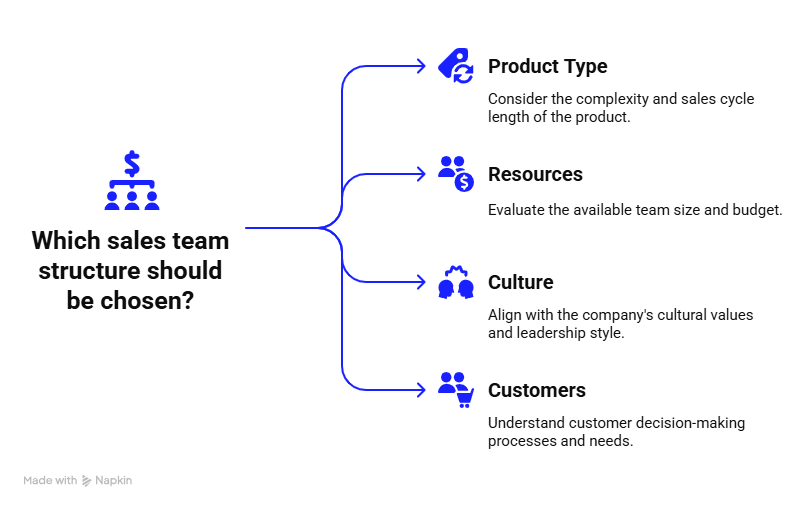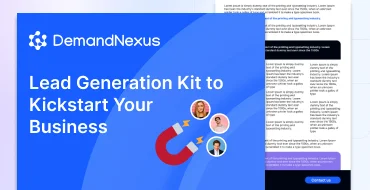In today’s fast-paced B2B landscape, building a high-performing sales team is more than just hiring top talent—it’s about crafting a structure that aligns with your business goals, fosters collaboration, and drives sustainable growth. A well-designed B2B sales team structure empowers your team to work efficiently, close deals faster, and build lasting client relationships. This guide dives deep into creating a proven framework for a B2B sales team that thrives, with insights on team structures, leadership, mentorship, coaching, and incentive programs to maximize performance.
Why Your B2B Sales Team Structure Matters
A B2B sales team structure defines how roles, responsibilities, and workflows are organized within your sales department. It’s the blueprint that ensures every team member knows their role in the sales funnel, from lead generation to deal closure. A thoughtfully designed structure aligns your team’s efforts with your company’s strategic objectives, boosting productivity and customer satisfaction.
A strong structure delivers:
- Higher Productivity: Clear roles eliminate confusion, allowing team members to focus on their strengths, whether it’s prospecting or closing.
- Lower Turnover: Defined responsibilities reduce frustration, fostering long-term engagement.
- Improved Customer Relationships: A streamlined process ensures clients receive timely, tailored responses, enhancing satisfaction.
- Scalability: A solid structure supports growth as your business expands into new markets.
Types of B2B Sales Team Structures
Choosing the right structure depends on your product, resources, and company culture. Here are three common B2B sales team structures:
1. The Island: Centralized and Autonomous
In the Island model, sales reps handle the entire sales cycle independently, from prospecting to closing. This structure suits startups or small businesses with limited resources, as it requires fewer specialized roles. However, it can strain reps managing complex sales cycles.
2. The Assembly Line: Specialized and Process-Driven
The Assembly Line divides the sales process into specialized roles, such as lead generation, qualification, and deal closure. Each team member focuses on a specific stage, creating a seamless pipeline. This model excels for companies with long, complex sales cycles, as it maximizes efficiency. Learn more about optimizing your pipeline with B2B lead generation strategies.
3. The Pod: Collaborative and Flexible
The Pod structure organizes team members into small, cross-functional groups that collaborate across the sales funnel. Including SDRs, account executives, and customer success specialists, pods foster teamwork and are ideal for businesses with complex products requiring tailored solutions.

B2B Sales Leadership: Setting the Tone
A great sales leader is the cornerstone of a high-performing team. They embody your company’s values, inspire their team, and drive strategic alignment. When hiring a sales leader, prioritize someone who excels at:
- Strategic Vision: Aligning sales goals with broader business objectives.
- Empathy: Understanding customer needs and team dynamics.
- Motivation: Inspiring reps to exceed targets through coaching and mentorship.
A leader who mirrors your company culture creates a positive environment where reps feel valued and empowered. For tips on building a cohesive team, check out our guide on sales prospecting techniques.
B2B Sales Mentorship and Coaching
Mentorship and coaching transform good reps into great ones. By fostering continuous learning, you empower your team to adapt to market changes and refine their skills.
Mentorship
Pair junior reps with seasoned mentors to share insights on navigating complex deals and building client relationships. Mentorship builds confidence and accelerates skill development.
Coaching
Regular coaching sessions, such as 1:1 deal reviews or role-playing, help reps improve specific skills like objection handling or storytelling. Encourage peer learning by sharing call recordings and best practices. For more on coaching, explore our SDR skills guide.
B2B Sales Incentive Programs
Incentives motivate reps to push boundaries while fostering healthy competition. Design programs that reward both individual and team achievements, such as:
- Performance Bonuses: Tied to revenue targets or deal closures.
- Recognition Programs: Publicly celebrating top performers.
- Team-Based Rewards: Encouraging collaboration with shared goals.
Transparent incentive structures align reps with company goals, driving results. Discover how to set measurable goals in our ABM metrics and KPIs guide.
Key Roles in a B2B Sales Team
A high-performing team relies on specialized roles to cover every stage of the sales process:
- Sales Development Representatives (SDRs): Focus on prospecting and qualifying leads to fill the pipeline. See how SDRs excel with BDR lead generation tactics.
- Account Executives (AEs): Close deals and nurture client relationships.
- Customer Success Specialists: Ensure post-sale satisfaction and retention.
- Sales Operations: Streamline processes and manage tech stacks.
- Sales Enablement: Provide training and tools for success.
Cultivating a Winning Sales Culture
A positive sales culture unites your team around shared values and goals. To build one:
- Define a Clear Mission: Align your team with your company’s vision.
- Foster Collaboration: Encourage knowledge-sharing and teamwork.
- Celebrate Wins: Recognize achievements to boost morale.
A collaborative culture drives performance and retention. Learn how to enhance team dynamics with SaaS sales strategies.
Leveraging Technology for Sales Success
Technology streamlines processes and boosts efficiency. Essential tools include:
- CRM Systems: Track interactions and personalize outreach.
- Outreach Tools: Automate prospecting and follow-ups.
- Data Providers: Ensure accurate lead information.
Invest in tools that match your team’s needs. Explore top options in our B2B sales software guide.
Measuring and Optimizing Performance
Track key performance indicators (KPIs) like revenue growth, lead conversion rates, and customer retention to gauge success. Regularly analyze data to identify trends and refine strategies. For a deeper dive, check our demand generation metrics guide.
Conclusion
Building a high-performing B2B sales team requires a strategic structure, strong leadership, and a culture that fosters growth. Whether you choose the Island, Assembly Line, or Pod model, success lies in aligning roles, leveraging technology, and nurturing collaboration. By setting clear goals, investing in coaching, and tracking performance, your sales team can become a powerhouse for driving revenue and customer satisfaction. Start building your dream team today with insights from our B2B sales team structure guide.



